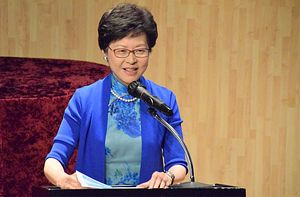As the network of high-speed rail in Chinese mainland is rapidly expanding, Hong Kong’s high-speed rail building is also in progress. The Guangzhou-Shenzhen-Hong Kong Express Rail, which will connect the mainland and Hong Kong, is expected to be in operation in 2018. However, the plan for the new railway station at West Kowloon, Hong Kong remains controversial. On October 3, the Hong Kong government said it will submit a non-binding motion to the Legislative Council to debate the plan, and if the motion passed, the government will formulate legislation accordingly.
Based on the arrangement of “one country, two systems,” when the Chinese mainlanders enter Hong Kong, they have to go through the border checkpoint with special visa. The border control also works for the Hong Kong people when they enter the mainland. So passengers who travelling on the traditional ordinary-speed trains must show passports at either end of their journey.
Yet, in late July, the Hong Kong government released the plan for the future rail station with some innovation on border control: according to the plan, a joint checkpoint will be set up in West Kowloon station, so that both Hong Kong and the mainland passengers can have their identities checked in the same building, though still separately through different checkpoints on different floors. The Hong Kong government said it is for the sake of convenience and efficiency. The Economist said the system is actually similar to that at the Eurostar terminal in London, which has both British and French immigration officials.
But as soon as the plan was announced, controversy broke out, since the plan will also allow the mainland law to be in force in parts of the station on Hong Kong territory, and mainland police officers armed with batons will also patrol the area controlled by the Chinese mainland government.
People who oppose the plan said it is totally against the Basic Law, the mini-constitution of Hong Kong. They also quoted the Article 18 of the Basic Law, which said: “The laws in force in the Hong Kong Special Administrative Region shall be this Law…National laws shall not be applied in the Hong Kong Special Administrative Region…”.
However, the Hong Kong government argued that, according to the plan, the 105,000 square meter area, designated as a port within the station where traveler have to abide by mainland laws, will be leased to the mainland government, so technically speaking that area will not be counted as Hong Kong soil, and thus it is not contradictory to the Basic Law. Furthermore, the similar joint-border control system has been working well for years in Shenzhen Bay Port, which is on the mainland territory and has been leased to the Hong Kong government.
Unfortunately, the argument cannot convince the opponents, against the backdrop in recent years that more and more people in Hong Kong fear the mainland government would infringe on Hong Kong’s autonomy as well as the rule of law.
In spite of the controversy, Hong Kong’s Chief Executive Carrie Lam has resolved to move the proposal forward. On October 3, she announced that the government would present a non-binding motion to the Legislative Council on October 25 to debate the plan. She emphasized that surveys have shown more than half of Hong Kong people support the plan as they do not think it violates “one country, two systems” and the Basic Law.
“I hope that Legislative Council members will debate this in a rational manner and reflect the opinions of the people of Hong Kong,” she said. She also added that after the passage of the motion, the Hong Kong government will formulate legislation early next year to prepare for the opening of the high-speed rail in the third quarter of next year.
The Hong Kong government said most recently that the high-speed rail building has progressed ahead of schedule, as the total project was already 94.3% complete as of June 30.

































